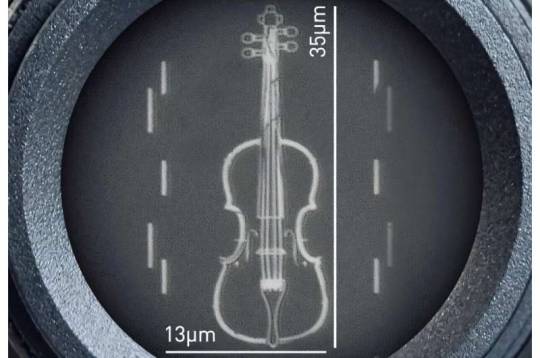#NanoTechnology
Explore tagged Tumblr posts
Text
"When bloodstream infections set in, fast treatment is crucial — but it can take several days to identify the bacteria responsible. A new, rapid-diagnosis sepsis test could cut down on the wait, reducing testing time from as much as a few days to about 13 hours by cutting out a lengthy blood culturing step, researchers report July 24 [2024] in Nature.
“They are pushing the limits of rapid diagnostics for bloodstream infections,” says Pak Kin Wong, a biomedical engineer at Penn State who was not involved in the research. “They are driving toward a direction that will dramatically improve the clinical management of bloodstream infections and sepsis.”
Sepsis — an immune system overreaction to an infection — is a life-threatening condition that strikes nearly 2 million people per year in the United States, killing more than 250,000 (SN: 5/18/08). The condition can also progress to septic shock, a steep drop in blood pressure that damages the kidneys, lungs, liver and other organs. It can be caused by a broad range of different bacteria, making species identification key for personalized treatment of each patient.
In conventional sepsis testing, the blood collected from the patient must first go through a daylong blood culturing step to grow more bacteria for detection. The sample then goes through a second culture for purification before undergoing testing to find the best treatment. During the two to three days required for testing, patients are placed on broad-spectrum antibiotics — a blunt tool designed to stave off a mystery infection that’s better treated by targeted antibiotics after figuring out the specific bacteria causing the infection.
Nanoengineer Tae Hyun Kim and colleagues found a way around the initial 24-hour blood culture.
The workaround starts by injecting a blood sample with nanoparticles decorated with a peptide designed to bind to a wide range of blood-borne pathogens. Magnets then pull out the nanoparticles, and the bound pathogens come with them. Those bacteria are sent directly to the pure culture. Thanks to this binding and sorting process, the bacteria can grow faster without extraneous components in the sample, like blood cells and the previously given broad-spectrum antibiotics, says Kim, of Seoul National University in South Korea.
Cutting out the initial blood culturing step also relies on a new imaging algorithm, Kim says. To test bacteria’s susceptibility to antibiotics, both are placed in the same environment, and scientists observe if and how the antibiotics stunt the bacteria’s growth or kill them. The team’s image detection algorithm can detect subtler changes than the human eye can. So it can identify the species and antibiotic susceptibility with far fewer bacteria cells than the conventional method, thereby reducing the need for long culture times to produce larger colonies.
Though the new method shows promise, Wong says, any new test carries a risk of false negatives, missing bacteria that are actually present in the bloodstream. That in turn can lead to not treating an active infection, and “undertreatment of bloodstream infection can be fatal,” he says. “While the classical blood culture technique is extremely slow, it is very effective in avoiding false negatives.”
Following their laboratory-based experiments, Kim and colleagues tested their new method clinically, running it in parallel with conventional sepsis testing on 190 hospital patients with suspected infections. The testing obtained a 100 percent match on correct bacterial species identification, the team reports. Though more clinical tests are needed, these accuracy results are encouraging so far, Kim says.
The team is continuing to refine their design in hopes of developing a fully automated sepsis blood test that can quickly produce results, even when hospital laboratories are closed overnight. “We really wanted to commercialize this and really make it happen so that we could make impacts to the patients,” Kim says."
-via Science News, July 24, 2024
#sepsis#medical news#medical testing#south korea#blood test#bacteria#antibiotics#infections#good news#hope#nanotechnology
2K notes
·
View notes
Text
A phone screen you can't scratch no matter how many times you drop it; glasses that prevent glare; a windshield that doesn't get dusty. These are all possibilities thanks to a new way to produce sapphire. Researchers at The University of Texas at Austin have discovered techniques to bestow superpowers upon sapphire, a material that most of us think of as just a pretty jewel. But sapphire is seen as a critical material across many different areas, from defense to consumer electronics to next-generation windows, because it's nearly impossible to scratch.
Continue Reading.
232 notes
·
View notes
Text
Last night I dreamed about nanotech tattoos. That could be really cool, depending on what kind of story it is.
Optimistic: you can change your tattoo any time you want, to reflect mood and identity and plot. It's great.
Pessimistic: rivals and criminals can hack your tattoo, and change it anytime they want. It sucks.
Dystopian: the government/corporation own your tattoo, and can change it anytime they want. It sucks a lot.
Rom-com: you meet someone else with a tattoo that says "soulmates don't exist" today, and you hit it off surprisingly well.
Comedy: this is a shiny new world for the possibilities of "kick me" signs.
And I'm sure there are plenty more I haven't thought of yet.
Oh! Detective. Dead bodies with clues they coded in just as they were dying, and shifty witnesses who don't dare say out loud what they know, but they can turn at a certain angle so their tattoo is visible for juuuuust a moment...
#writing prompts#nanotechnology#tattoos#tropes#all of this works for magical tattoos as well of course#just with slightly different vibes#it'd be interesting to see a dystopian-trope fantasy story#not uplifting#but interesting#and some of those others sound promising indeed#somebody should write them
129 notes
·
View notes
Text

Physicists create 'the world's smallest violin' using nanotechnology
Physicists at Loughborough University have used cutting-edge nanotechnology to create what they believe may be "the world's smallest violin," which is small enough to fit within the width of a human hair. The violin is made of platinum and measures just 35 microns long and 13 microns wide, with a micron being one millionth of a meter. For size comparison, a human hair typically ranges from 17 to 180 microns in diameter, and the much-loved microscopic creatures known as tardigrades measure between 50 and 1,200 microns. The miniature violin was created as a test project to demonstrate the capabilities of the university's new nanolithography system—an advanced suite of technology that enables researchers to build and study structures at the nanoscale. The system will support a variety of research projects aimed at identifying new materials and methods for developing the next generation of computing devices.
Read more.
60 notes
·
View notes
Text
To date, superlubricity has always been isotropic: the friction is cancelled in all directions equally. Now, with this new discovery, a new form of superlubricity is achieved, where the friction is zero in one direction only, and has conventional friction in other directions.
40 notes
·
View notes
Text

Veronica Honeycolm / Zombee
Species: Bio-Hive Nationality: American Powers: Nanite Bee Control, Hive Mind, Flight, Weak Self-Sustenance Role: Combatant/Intelligence
Teen heiress of the Honeycolm family and it girl of Upper East Side, Veronica grew up rich, spoiled and carefree. This would change during the first Apoidax Invasion, however, as she would be among the victims of their techno-organic virus, becoming one of their quasi-living "Hives". Following the HFA forcing the Apoidax to retreat, her father would put forth great sums to have the HFA revert her Hive state, which was thought irreversible. Some success in this would be achieved by Dr. Pyre through fusing a Hero Core into her, the Quaza reprogramming the virus to give her back free will, as well as granting her control of the techno-organic nanites inside her. Upon reawakening, she’d be horrified by her new appearance, being albino-like and covered in small holes. Through therapy and time, she would come some terms her state and join HFA at the urging of Mr. M, so they could help her use her powers responsibly. Though her entitled and shallow outer personality would initially clash with her teammates, primarily Roxi Rossi, the two women would eventually bond over their similar victim trauma, becoming vitriolic, but close, friends. Additional experience and discipline under Captain Hall’s command has also help to being shaping Veronica into an overall better person.
Being suited more for recon and ranged than direct combat, Veronica generally keeps to the air, using her nanite bees to survey the field while laying fire with her arm cannon. Given both her lighter armor and body build, she relies heavily on evasion, solid hits being able to easily drop her. Outside of her physical capabilities, she holds the role of the most charismatic and socially adept of her team, able to maneuver people through a combination of charm, derision and blackmail. Her high society familial connections additionally grant her team access to exclusive social circles.
#bionicle#lego moc#slay queen#slayin while she slayin#yass queen#hero factory#zombie#nanotechnology#mean girls#queen#bees#queen bee
33 notes
·
View notes
Note
Hear me out based on your shrinking mech post. What about a mech show where the mecha are antibodies fighting viruses. Like gundam/cells at work. Is that anything
Ooh yes that is definitely something! I see two approaches you could do with it, both seem interesting:
1) It's about real cells, they're just depicted as mecha for stylistic reasons, much like how Cells At Work personifies the cells as people but isn't literally saying "this is a world where everyone has tiny people living inside them."
2) It's a scifi where diseases and other ailments are treated by nanomachines that actually are tiny mecha in-universe, either piloted remotely or sentient on their own.
Or maybe a middle ground where the mecha are nanomachines but the cells are also stylized as humanoids if not full humans? Hmm... what if... the mecha are nanomachines piloted remotely via some kind of VR setup or neural link, but because the inside of a human body is such an unfamiliar place it all gets "translated" into a world the pilots can more easily understand, with cells appearing to them as people, viruses as monsters, organs as landscapes and buildings, etc.?
I mean this is all pretty unrealistic and just an excuse to show epic robot fights, but that's never stopped mecha media before XD Also I am very tired right now so I hope my rambling made any sense at all
27 notes
·
View notes
Text
DARPA’S “SMART DUST” EXPLAINED
😬😬
#darpa#smart dust#mind control#crimes against humanity#ai#world control#deep state#these people are evil#microchips#nanotechnology#truth#please share#wwg1wga
16 notes
·
View notes
Text
*The autobots as nanobots*
Optimus Prime: nanobots, roll out!
*tiny transformers song plays*
58 notes
·
View notes
Text

#science#light#technology#graphene#free energy#ascension#consciousness#energy#magic#engineering#nanotechnology#the future#quantum mechanics#quotes#alchemy#walter russell
45 notes
·
View notes
Text
"A team at Northwestern University has come up with the term “dancing molecules” to describe an invention of synthetic nanofibers which they say have the potential to quicken the regeneration of cartilage damage beyond what our body is capable of.
The moniker was coined back in November 2021, when the same team introduced an injection of these molecules to repair tissues and reverse paralysis after severe spinal cord injuries in mice.
Now they’ve applied the same therapeutic strategy to damaged human cartilage cells. In a new study, published in the Journal of the American Chemical Society, the treatment activated the gene expression necessary to regenerate cartilage within just four hours.
And, after only three days, the human cells produced protein components needed for cartilage regeneration, something humans can’t do in adulthood.
The conceptual mechanisms of the dancing molecules work through cellular receptors located on the exterior of the cell membrane. These receptors are the gateways for thousands of compounds that run a myriad of processes in biology, but they exist in dense crowds constantly moving about on the cell membrane.
The dancing molecules quickly form synthetic nanofibers that move according to their chemical structure. They mimic the extracellular matrix of the surrounding tissue, and by ‘dancing’ these fibers can keep up with the movement of the cell receptors. By adding biological signaling receptors, the whole assemblage can functionally move and communicate with cells like natural biology.
“Cellular receptors constantly move around,” said Northwestern Professor of Materials Sciences Samuel Stupp, who led the study. “By making our molecules move, ‘dance’ or even leap temporarily out of these structures, known as supramolecular polymers, they are able to connect more effectively with receptors.”
The target of their work is the nearly 530 million people around the globe living with osteoarthritis, a degenerative disease in which tissues in joints break down over time, resulting in one of the most common forms of morbidity and disability.
“Current treatments aim to slow disease progression or postpone inevitable joint replacement,” Stupp said. “There are no regenerative options because humans do not have an inherent capacity to regenerate cartilage in adulthood.”
In the new study, Stupp and his team looked to the receptors for a specific protein critical for cartilage formation and maintenance. To target this receptor, the team developed a new circular peptide that mimics the bioactive signal of the protein, which is called transforming growth factor beta-1 (TGFb-1).
Northwestern U. Press then reported that the researchers incorporated this peptide into two different molecules that interact to form supramolecular polymers in water, each with the same ability to mimic TGFb-1...
“With the success of the study in human cartilage cells, we predict that cartilage regeneration will be greatly enhanced when used in highly translational pre-clinical models,” Stupp said. “It should develop into a novel bioactive material for regeneration of cartilage tissue in joints.”
“We are beginning to see the tremendous breadth of conditions that this fundamental discovery on ‘dancing molecules’ could apply to,” Stupp said. “Controlling supramolecular motion through chemical design appears to be a powerful tool to increase efficacy for a range of regenerative therapies.”"
-via Good News Network, August 5, 2024
#nanotechnology#osteoarthritis#arthritis#medical news#science news#cell biology#molecular biology#cartilage#good news#hope
774 notes
·
View notes
Text
A research team from the Eye & ENT Hospital of Fudan University, China, has developed a novel biocompatible nanoadhesive for corneal transplantation. The nanoadhesive is based on tetrahedral framework nucleic acids combined with functionalized polycationic recombinant proteins. This unique composition minimizes the risks of tissue necrosis and inflammation associated with polymeric adhesives while inhibiting bacterial growth and promoting tissue repair. This work demonstrates an efficient strategy to break through the bottleneck of current ophthalmic adhesives. Developing safe and efficient tissue adhesives is urgently required in current ophthalmology practices to avoid traumatic suturing surgery. Although a variety of polymeric adhesives have been used to repair human tissue, their application in ocular tissue adhesion, especially in corneal transplantation, is still restricted to the preclinical stage.
Continue Reading.
92 notes
·
View notes
Text

#tony stark#iron man#marvel cinematic universe#nanotechnology#the avengers#meme#marvel memes#rip#avengers endgame
95 notes
·
View notes
Text

An accidentally discovered class of nanostructured materials can passively harvest water from air
A serendipitous observation in a Chemical Engineering lab at Penn Engineering has led to a surprising discovery: a new class of nanostructured materials that can pull water from the air, collect it in pores and release it onto surfaces without the need for any external energy. The research, published in Science Advances, describes a material that could open the door to new ways to collect water from the air in arid regions and devices that cool electronics or buildings using the power of evaporation. The interdisciplinary team includes Daeyeon Lee, Russell Pearce and Elizabeth Crimian Heuer Professor in Chemical and Biomolecular Engineering (CBE); Amish Patel, Professor in CBE; Baekmin Kim, a postdoctoral scholar in Lee's lab and first author; and Stefan Guldin, Professor in Complex Soft Matter at the Technical University of Munich.
Read more.
#Materials Science#Science#Nanotechnology#Water harvesting#Water#Surfaces#Amphiphilic#University of Pennsylvania
28 notes
·
View notes
Text
I respect the nanotech suits but damn something about the earlier suit transitions is just so cool





46 notes
·
View notes
Text
Scientists at Rice University and University of Houston have developed an innovative, scalable approach to engineer bacterial cellulose into high-strength, multifunctional materials. The study, published in Nature Communications, introduces a dynamic biosynthesis technique that aligns bacterial cellulose fibers in real-time, resulting in robust biopolymer sheets with exceptional mechanical properties.
26 notes
·
View notes